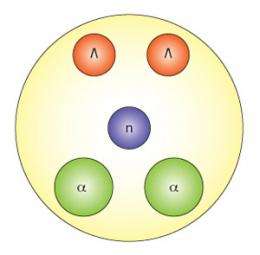Nuclear physics incorporates a 'strange' flavor

Calculating the binding energy between hyperon particles contributes to understanding a new type of neutron star.
In 2009, physicists from Japan’s KEK high-energy proton accelerator announced the sighting of a rare event: an unusually bulky beryllium nucleus that, in addition to four protons and five neutrons, contained two particles called 'hyperons'.
Now, Emiko Hiyama at the RIKEN Nishina Center for Accelerator-Based Science, Wako, and her colleagues from several Japanese universities have presented a calculation that provides the most precise description available of the interactions between nuclei and hyperons in the double-hyperon beryllium nucleus observed at KEK1.
Hyperons—particles that contain at least one so-called ‘strange’ quark—exist for less than a billionth of a second before they decay. Scientists know relatively little about how hyperons interact with matter, but speculate that the hot, dense environment of a neutron star would allow these particles to exist in an almost stable state. If they are correct, a hyperon neutron star would be a new state of matter.
According to Hiyama, one of the main interests of hypernuclear physics is to understand interactions between baryons—particles such as protons and neutrons that consist of three quarks—and other particles. “Our study will contribute to understanding such interactions at the core of a neutron star.”
Quarks come in six so-called ‘flavors’: up, down, strange, charm, bottom and top. Only the up and down quarks, which make up the protons and neutrons in atomic nuclei, are stable. High-energy collisions, such as those performed at KEK, are needed to produce the hyperons that contain the more massive strange quark.
Finding the interactions between the eleven particles that constitute the double-hyperon beryllium nucleus is prohibitively difficult. To simplify the calculation of this ‘many-body’ problem, Hiyama and her colleagues approximated the double-hyperon nucleus as five particles: two helium nuclei, one neutron and the two hyperon particles. This allowed them to predict the energy that binds the two hyperons together in the nucleus and compare their theoretical results with experimental data. Their calculations indicated that hyperons act to shrink the beryllium nucleus—an unusual effect, since nuclei are normally considered incompressible.
Hiyama’s calculations will be an essential tool to understand the attractive forces between hyperons in a neutron star, and will help researchers to analyze experimental results at Japan’s new proton accelerator complex, J-PARC, which is expected to produce multiple double-hyperon nuclei.
“At present, the only way to determine the energy of the hypernucleon is to perform these accurate many-body calculations,” says Hiyama.
More information: Hiyama, E., Kamimura, M., Yamamoto, Y. & Motoba, T. Five-body cluster structure of the double-Λ hypernucleus 11ΛΛBe. Physical Review Letters 104, 212502 (2010). prl.aps.org/abstract/PRL/v104/i21/e212502
Provided by RIKEN

















